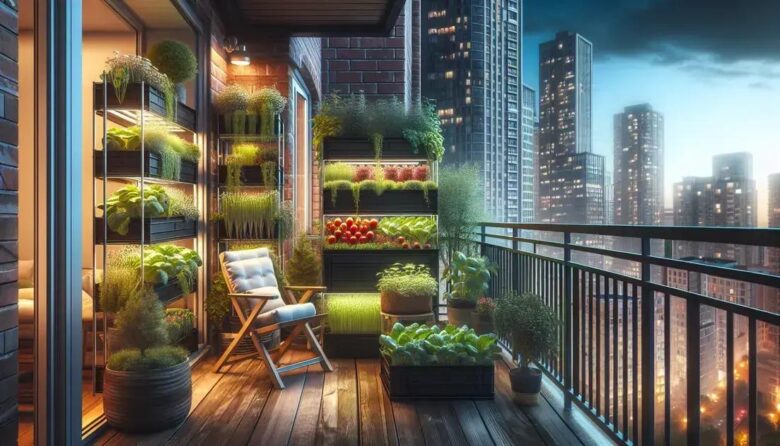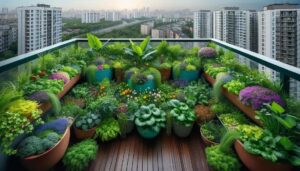Self-watering containers efficiently maintain soil moisture, reducing the need for frequent maintenance, and are ideal for growing vegetables on balconies where space optimization and consistent hydration are essential for plant health.
Self-watering containers can revolutionize how you grow vegetables on your balcony. Ever struggled with watering schedules or space constraints? These innovative solutions simplify the process, making home gardening accessible and enjoyable. Imagine harvesting fresh veggies from your own balcony with ease!
understanding self-watering containers
Self-watering containers are ingenious solutions for modern gardening enthusiasts who want to grow plants with minimal maintenance. These containers have a built-in water reservoir at the bottom, allowing plants to absorb water through capillary action as needed. This means plants get consistent moisture, reducing the risk of overwatering or underwatering.
How Self-Watering Containers Work
The key to a self-watering container is its dual-chamber design. The upper chamber holds soil and the plant, while the lower chamber functions as a water reservoir. A wick or a series of holes allows water to move upward to the plant’s roots.
Most systems also include an overflow outlet to prevent the reservoir from being too full. This feature ensures that excess water drains out, protecting plants from root rot.
Benefits for Balcony Gardeners
For balcony gardeners, these containers are a game-changer. With space constraints, efficient watering becomes critical. Self-watering systems are particularly advantageous in urban settings where access to water can be less frequent or more challenging.
If you’re dealing with limited sunlight due to tall buildings, self-watering containers help plants thrive by providing consistent hydration even when photosynthesis is reduced.
Additionally, these systems can extend your gardening season by maintaining proper moisture levels even as temperatures fluctuate, making them perfect for vegetables and herbs.
advantages of balcony gardening with vegetables
Balcony gardening offers unique advantages for urban dwellers who wish to cultivate their own vegetables. One of the primary benefits is space optimization. Even a small balcony can accommodate a variety of plants if arranged strategically, providing a green sanctuary amidst a concrete jungle.
Another significant advantage is convenience. With your garden just steps away, it becomes easy to integrate fresh produce into daily meals. This accessibility encourages a healthier lifestyle and deeper appreciation for home-grown food.
Growing vegetables on a balcony also contributes to sustainability. It reduces reliance on store-bought produce and minimizes transport emissions since there’s no need to drive to a grocery store. Plus, using organic practices and composting kitchen waste promotes an eco-friendly environment.
Microclimate control is another perk. Balconies can offer a warm shelter from wind or cold, enabling certain vegetables to thrive. As a gardener, you have the flexibility to adjust the amount of sunlight or shade, catering to the specific needs of your plants.
Moreover, balcony gardening can be a rewarding hobby. It provides mental relaxation and the satisfaction of nurturing plants from seed to harvest. Watching your efforts materialize into fresh, vibrant produce can boost your mood and offer a sense of accomplishment.
choosing the right containers for your space
Choosing the right containers is fundamental for maximizing your balcony garden’s potential. Containers come in various materials like plastic, clay, and metal, each with their pros and cons. Plastic containers are lightweight and affordable, excellent for beginners on a budget. They retain moisture well, reducing how often you need to water.
Clay pots, while heavier, are breathable, allowing air to circulate around roots. This is ideal for plants that prefer drier conditions. However, they can dry out quickly in hot weather, so consistent watering is essential.
Consider your balcony’s size and weight restrictions before selecting large or heavy pots. Opt for stackable or vertical planters if space is tight. These designs let you plant upwards, making the most of limited areas.
Drainage is key in container gardening. Ensure your pots have holes to prevent water from accumulating at the base, which can cause root rot. If needed, drill additional holes or line the bottom with stones to enhance drainage.
Lastly, think about the vegetables you plan to grow. Deep-rooted plants like tomatoes and carrots need larger and deeper containers. On the other hand, herbs and leafy greens thrive in shallower planters.
how to properly set up your self-watering system
Setting up a self-watering system efficiently ensures that your balcony garden thrives with minimal effort. Start by choosing a suitable container with a built-in reservoir. This container should have a clear separation between the soil and the water compartment to prevent root rot.
Install a wicking mechanism, such as a nylon rope or capillary mat, that will draw water from the reservoir to the soil. This setup creates a continuous supply of moisture to the plants’ roots. It’s important to set the wick properly. Place it so one end is submerged in water while the other is embedded in the soil.
Fill the reservoir with water until it reaches the designated fill line. Avoid overfilling, as this could lead to waterlogging. If your system includes a fill tube, use it periodically to maintain the water level.
Next, plant your vegetables. Ensure the soil is packed around the plants to eliminate air pockets. Water the soil initially from the top to help the plants establish their roots downwards towards the moisture source.
Position the containers in a location that receives adequate sunlight but is protected from harsh winds. You can move them as needed based on seasonal light changes. Check the water level in the reservoir regularly, especially during hot months, to ensure continuous hydration.
tips for growing vegetables successfully on your balcony
Growing vegetables on your balcony can be a rewarding endeavor when armed with the right tips. Start by selecting vegetables suited for container gardening. Leafy greens like lettuce and spinach, as well as herbs, are ideal for small spaces and thrive with minimal care.
Ensure your plants receive ample sunlight. Most vegetables need 6-8 hours of sun daily. If your balcony has limited sun exposure, consider positioning mirrors or opting for shade-tolerant crops like leafy greens.
Use high-quality potting soil that retains moisture but also offers good drainage. Soil designed for containers usually has the right balance of nutrients and prevents waterlogging, crucial for preventing root issues.
Water regularly, but avoid overwatering. Self-watering containers can help maintain consistent moisture levels, which is essential for plant health. Monitor the top inch of soil; if it feels dry, it’s time to water.
Fertilizing is necessary since nutrients can deplete quickly in containers. Use a balanced liquid fertilizer every 2-3 weeks to keep your plants nourished. This helps them grow strong and enhances yield.
Finally, keep an eye out for pests. Balconies can host common garden pests like aphids or spider mites. Regular inspections and organic pest control solutions can mitigate infestations without harmful chemicals.
common mistakes and how to avoid them
Gardening on a balcony comes with its own set of challenges, and knowing the common mistakes can help you avoid them. Overwatering is one frequent error. It can lead to root rot and fungus. Use containers with drainage holes and consider self-watering pots to maintain appropriate moisture levels.
Another pitfall is selecting the wrong plants for your space. Choose vegetables and herbs that thrive in containers and are suited to your balcony’s sun exposure. Understanding the light requirements of each plant helps prevent wilting or spindly growth caused by insufficient light.
Incorrect soil choice can also hinder plant growth. Avoid using garden soil in containers as it’s too heavy and doesn’t drain well. Opt for a quality potting mix designed for container gardening, ensuring it includes both organic material and adequate drainage properties.
Pests and diseases can be overlooked, especially on balconies. Regularly inspect plants for signs of pests like aphids or diseases such as powdery mildew. Promptly treat any issues with organic solutions to prevent outbreaks.
Lack of consistent care is another mistake. Plants in containers need regular monitoring for water levels and nutrient needs. Create a schedule to water, feed, and check your plants to foster a thriving balcony garden.
Conteúdo não disponível
FAQ – Common Questions About Balcony Gardening with Self-Watering Containers
What are the benefits of using self-watering containers?
Self-watering containers reduce the need for daily watering and provide consistent moisture to plants, which promotes healthy growth.
Which vegetables are ideal for growing on a balcony?
Vegetables like leafy greens, herbs, tomatoes, and peppers are well-suited for balcony gardening due to their size and sunlight needs.
How do I prevent pests in my balcony garden?
Regularly inspect plants for signs of pests. Use organic pest control methods, such as neem oil or insecticidal soap, to manage outbreaks.
How much sunlight do my balcony plants need?
Most vegetables need at least 6-8 hours of sunlight. Adjust plant placement or use mirrors to maximize light exposure on your balcony.
Can I use regular garden soil in my containers?
No, garden soil is too heavy and doesn’t drain well. Use a quality potting mix designed for containers to ensure proper aeration and drainage.
How do I know if I’m overwatering my plants?
Check the soil’s top inch with your finger. If it’s still moist, wait before watering again. Overwatering often shows as yellowing leaves and soil that remains wet.



